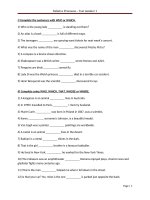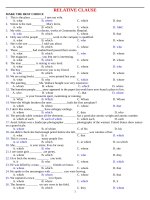BÀI TẬP Mệnh đề quan hệ pdf
Bạn đang xem bản rút gọn của tài liệu. Xem và tải ngay bản đầy đủ của tài liệu tại đây (181.92 KB, 3 trang )
On thi TNPTTH
BÀI TẬP Mệnh đề quan hệ
MDQH là mệnh đề phụ, được dùng để bổ nghĩa cho danh từ đứng trước nó.
MDQH được nối với mệnh đề chính bởi các đại từ quan hệ WHO, WHOM, WHICH, WHOSE, THAT
hoặc các phó từ quan hệ WHEN, WHERE, WHY.
MDQH đứng ngay sau danh từ mà nó bổ nghĩa.
I. Cách dùng:
1, WHO: là đại từ quan hệ chỉ người, đứng ngay sau danh từ chỉ người và làm chủ ngữ trong MDQH.
Eg: The man is my father. He is watching TV in the room .
The man who is watching TV in the room is my father.
2, WHOM: là đại từ quan hệ chỉ người, đứng sau danh từ chỉ người và làm tân ngữ trong MDQH.
Eg: The woman is my aunt. You saw her yesterday.
The woman whom you saw yesterday is my aunt.
3, WHICH: là đại từ quan hệ chỉ vật, đứng sau danh từ chỉ vật làm chủ ngữ hoặc làm tân ngữ trong MDQH.
Eg: This is the book. I like it best.
This is the book which I like best.
The hat is mine. It is red.
The hat which is red is mine.
4, THAT: thay thế cho người, vật; làm chủ từ, tân ngữ trong MĐQH.
Ex: - I need to meet the boy that is my friend’s son.
- The woman that is standing over there is my sister.
- I know the girl that I spoke to.
- The man that your father is talking to is my teacher.
- She works for a company that makes cars.
- The elephants that people keep in iron cages are big.
5. WHOSE (OF WHICH): thay thế cho sở hữu của người, vật (his-, her-, its-, their-).
Ex: - John found the cat. Its leg was broken.
John found the cat whose leg/(the leg of which) was broken.
- This is the student. I borrowed his book.
This is the student whose book I borrowed.
6. WHERE: là phó từ quan hệ, thay thế cho cụm từ chỉ nơi chốn: there, at that place.
Ex: - The movie theater is the place. We can see films at that place.
The movie theater is the place where we can see films.
7. WHY: là phó từ quan hệ ,thay thế cho cụm trạng từ chỉ lí do: for that reason.
Ex: - Tell me the reason. You are so sad for that reason.
Tell me the reason why you are so sad.
8. WHEN: là phó từ quan hệ, thay thế cho cụm từ chỉ thời gian: then, at that time, on that day.
Ex: - Do you remember the day. We first met on that day.
Do you remember the day when we first met?
II. Phân loại: Có 2 loại MDQH
1. MDQH xác định: Là mệnh đề cần thiết vì có chức năng xác định cho danh từ đứng trước, không có nó câu
sẽ không đủ nghĩa.
Eg: The man is Mr Green. He keeps the school library.
The man who keeps the library is Mr Green.
That is the book. I like it best.
That is the book which I like best.
On thi TNPTTH
2. MDQH không xác định:là mệnh đề không cần thiết vì danh từ nó bổ nghĩa đã được xác định, không có nó
câu vẫn đủ nghĩa.
- Được ngăn cách với MD chính bắng các dấu phẩy. Trước danh từ thường có “this, that, these, those và các
tính từ sở hữu hoặc danh từ nó bổ nghĩa là danh từ riêng.”
Eg: That woman is Mrs Pike. You saw her yesterday.
That woman, whom you saw yesterday, is MRs Pike.
This is Mrs Jones. She helped me last week.
This is Mrs Jones, who helped me last week.
* Note: Không dùng “THAT” trong MDQH không xác định.
III Đại từ quan hệ có giới từ đi kèm: (WHOM/WHICH)
* Trong MDQH, khi đại từ QH làm tân ngữ của giới từ thì ta có thể đặt giới từ lên trước ĐTQH.
Ex: - The man speaks English very fast. I talked to him last night.
The man to whom I talked last night speaks English very fast.
- The house is for sale. I was born in it.
The house in which I was born is for sale.
* LƯU Ý: KHÔNG dùng THAT sau giới từ.
The house in that I was born is for sale.
IV. OF WHICH / OF WHOM:
Ex: - Daisy has three brothers. All of them are teachers.
Daisy has three brothers, all of whom are teachers.
- He asked me a lot of questions. I couldn’t answer most of them.
He asked me a lot of questions, most of which I couldn’t answer.
V. Reduced forms of relative clause (Rút gọn MDQH)
* V trong MDQH ở thể chủ động Ving (bỏ đại từ QH và trợ V, đưa V chính về dạng nguyên thể + ING)
Eg: The man who is sitting next to you is my uncle.
The man sitting next to you is my uncle.
- Do you know the boy who broke the windows last night?
Do you know the boy breaking the windows last night?
* V trong MDQH ở thể bị động PII (bỏ đại từ QH, và trợ V, thay bằng PII).
Eg: The books which were written by To Hoai are interesting.
The book written by To Hoai are interesting.
- The students who were punished by the teacher are lazy.
The students punished by the teacher are lazy.
* To Infinitive được dùng:
- sau the first/second…the last/only và sau so sánh nhất
Eg: The first man that we must see is Tom.
The first man to see is Tom
- The first man that was seen is Tom.
The first man to be seen is Tom.
- khi diễn đạt mục đích hoặc sự cho phép
Eg: She had something that she had to do.
She had something to do.
* Lược bỏ đại từ quan hệ khi: MDQH xác định + đại từ quan hệ làm tân ngữ + không có giới tù đứng trước nó
Eg: I like the diamond ring which Mary is wearing.
I like the diamond ring Mary is wearing.
On thi TNPTTH
VI. Practice:
A. Combine 2 sentences by using relative pronouns or relative adverb:
1. This is Mrs Johnson. Her son won the championship last year.
2. Please post these letters. I wrote them this morning.
3. Is this the style of hair? Your wife want to have it.
4. A man answered the phone. He said Tom was out.
5. The girl turned out to be an enemy spy. He trusted her absolutely.
6. This is the house. We often stay in this house in the summer.
7. That was the time. He managed the enterprise at that time.
8. I never forget the park. We met each other for the first time at this didn’park.
9. You didn’t twll us the reason. We had to cut down our daily expenses for that reason.
10. I do not know the reason. She left school for it.
B. Reduce relative clause:
1. The boy who is playing the piano is Ben
2. The fence which surrounds our house is made of wood
3. Benzene, which was discovered by Faraday, became the starting point in the manufacture of many perfumes.
4. The students don’t know how to do the exercises which were given by the teacher yesterday.
5. Mr Jackson, who teaches my son, is my neighbour.
6. They work in a hospital which was sponsored by the government.
7. John was the last man who reached the top of the mountain.
8. The last person who leaves the room must turn off the light.
9. The first person that we must see is Mr Smith
10. This is the second person who was killed in that way.
C. Omission of relative pronouns:
1. Are these the keys that you are looking for?
2. The girl who we are going to see is from Britain.
3. He works for the company that makes cars.
4. What was the name of the man who you met yesterday?
5. The table that was broken has now been repaired.
D. Relative pronouns with preposition:
1. She is the woman. I told you about her.
2. The song was interesting. We listened to it last night.
3. The man was very kind. I talked to him yesterday.
4. The movie is fantastic. They are talking about it
5. The picture was beautiful. She was looking at it.
6. I’ll give you the address. You should write to it
7. The woman teaches me English. I am telling you about her.









